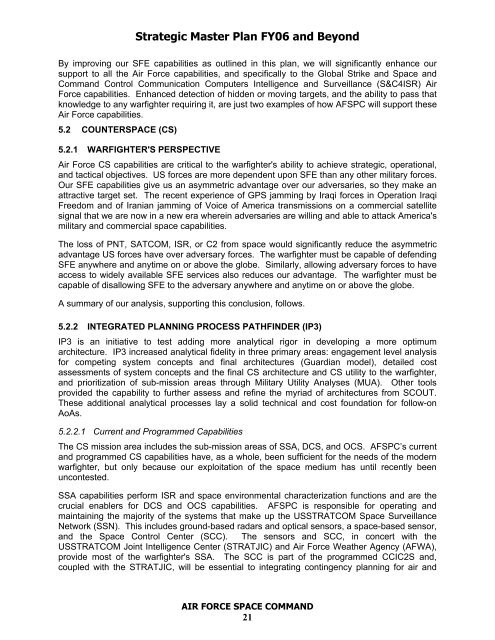STRATEGIC MASTER PLAN FY06 and Beyond - Western States ...
STRATEGIC MASTER PLAN FY06 and Beyond - Western States ...
STRATEGIC MASTER PLAN FY06 and Beyond - Western States ...
You also want an ePaper? Increase the reach of your titles
YUMPU automatically turns print PDFs into web optimized ePapers that Google loves.
Strategic Master Plan <strong>FY06</strong> <strong>and</strong> <strong>Beyond</strong><br />
By improving our SFE capabilities as outlined in this plan, we will significantly enhance our<br />
support to all the Air Force capabilities, <strong>and</strong> specifically to the Global Strike <strong>and</strong> Space <strong>and</strong><br />
Comm<strong>and</strong> Control Communication Computers Intelligence <strong>and</strong> Surveillance (S&C4ISR) Air<br />
Force capabilities. Enhanced detection of hidden or moving targets, <strong>and</strong> the ability to pass that<br />
knowledge to any warfighter requiring it, are just two examples of how AFSPC will support these<br />
Air Force capabilities.<br />
5.2 COUNTERSPACE (CS)<br />
5.2.1 WARFIGHTER'S PERSPECTIVE<br />
Air Force CS capabilities are critical to the warfighter's ability to achieve strategic, operational,<br />
<strong>and</strong> tactical objectives. US forces are more dependent upon SFE than any other military forces.<br />
Our SFE capabilities give us an asymmetric advantage over our adversaries, so they make an<br />
attractive target set. The recent experience of GPS jamming by Iraqi forces in Operation Iraqi<br />
Freedom <strong>and</strong> of Iranian jamming of Voice of America transmissions on a commercial satellite<br />
signal that we are now in a new era wherein adversaries are willing <strong>and</strong> able to attack America's<br />
military <strong>and</strong> commercial space capabilities.<br />
The loss of PNT, SATCOM, ISR, or C2 from space would significantly reduce the asymmetric<br />
advantage US forces have over adversary forces. The warfighter must be capable of defending<br />
SFE anywhere <strong>and</strong> anytime on or above the globe. Similarly, allowing adversary forces to have<br />
access to widely available SFE services also reduces our advantage. The warfighter must be<br />
capable of disallowing SFE to the adversary anywhere <strong>and</strong> anytime on or above the globe.<br />
A summary of our analysis, supporting this conclusion, follows.<br />
5.2.2 INTEGRATED <strong>PLAN</strong>NING PROCESS PATHFINDER (IP3)<br />
IP3 is an initiative to test adding more analytical rigor in developing a more optimum<br />
architecture. IP3 increased analytical fidelity in three primary areas: engagement level analysis<br />
for competing system concepts <strong>and</strong> final architectures (Guardian model), detailed cost<br />
assessments of system concepts <strong>and</strong> the final CS architecture <strong>and</strong> CS utility to the warfighter,<br />
<strong>and</strong> prioritization of sub-mission areas through Military Utility Analyses (MUA). Other tools<br />
provided the capability to further assess <strong>and</strong> refine the myriad of architectures from SCOUT.<br />
These additional analytical processes lay a solid technical <strong>and</strong> cost foundation for follow-on<br />
AoAs.<br />
5.2.2.1 Current <strong>and</strong> Programmed Capabilities<br />
The CS mission area includes the sub-mission areas of SSA, DCS, <strong>and</strong> OCS. AFSPC’s current<br />
<strong>and</strong> programmed CS capabilities have, as a whole, been sufficient for the needs of the modern<br />
warfighter, but only because our exploitation of the space medium has until recently been<br />
uncontested.<br />
SSA capabilities perform ISR <strong>and</strong> space environmental characterization functions <strong>and</strong> are the<br />
crucial enablers for DCS <strong>and</strong> OCS capabilities. AFSPC is responsible for operating <strong>and</strong><br />
maintaining the majority of the systems that make up the USSTRATCOM Space Surveillance<br />
Network (SSN). This includes ground-based radars <strong>and</strong> optical sensors, a space-based sensor,<br />
<strong>and</strong> the Space Control Center (SCC). The sensors <strong>and</strong> SCC, in concert with the<br />
USSTRATCOM Joint Intelligence Center (STRATJIC) <strong>and</strong> Air Force Weather Agency (AFWA),<br />
provide most of the warfighter's SSA. The SCC is part of the programmed CCIC2S <strong>and</strong>,<br />
coupled with the STRATJIC, will be essential to integrating contingency planning for air <strong>and</strong><br />
AIR FORCE SPACE COMMAND<br />
21
















